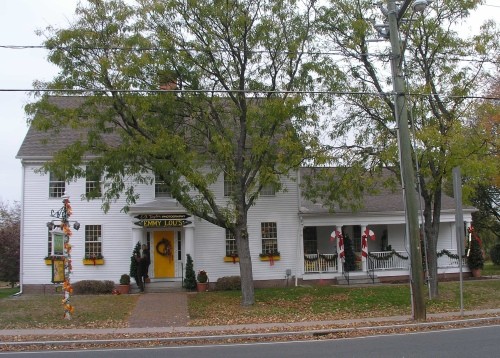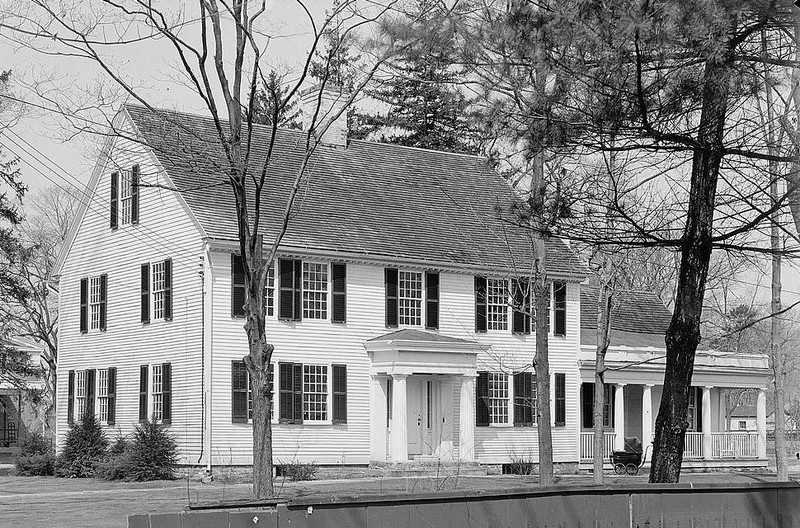Gideon Welles House
Introduction
Text-to-speech Audio
Images
The property is best known as the home of Civil War-era Secretary of Navy Gideon Welles.

Gideon Welles House from 1937

Backstory and Context
Text-to-speech Audio
The Gideon Welles House has stood in the Hartford area (now Glastonbury) since 1783 and most famously existed as the home of Gideon Welles, the United States Secretary of the Navy under Abraham Lincoln during the American Civil War. Gideon was one of many generations of prominent Welles family members to live in the home and on land owned by the Welles family since 1649, including those who served in high profile political and military positions. Similar to other wealthy New England families in the colonial period and early republic, the family also held several persons as enslaved laborers until the state gradually abolished slavery between 1784 and 1848. The family stayed on the property and home until 1932.
Thomas Welles (July 10, 1594 - January 14, 1660), an English-born immigrant to the colonies, is the only person in Connecticut's history to hold all four top offices: governor, deputy governor, treasurer, and secretary. In 1649, six years before serving as the colony's fourth governor, Thomas purchased the land that would stay in the family for more than two and a half centuries. Nearly a century and a half after Thomas purchased the land, Captain Samuel Welles, who served in the Revolutionary War, built the first-class home on the property in 1783 for his son Samuel. The grand estate consisted of 22 rooms, an abundance of carriage houses and amenities, and slave houses. (A series of laws passed from 1784 to 1848 slowly abolished slavery in Connecticut, with its absolute abolition coming in 1848. For more, see the additional links provided at the end of this entry.)
In 1802, Gideon Welles -- Samuel's son and the seventh generation Welles after Thomas -- was born in the house. Gideon gained distinction as a successful state politician, continuing his family's role as influential in civic affairs. Still, his most notable role came during the Civil War when he served as President Lincoln's Secretary of Navy in 1861. Though Gideon was known to be an opinionated and often argumentative cabinet member, he served Lincoln faithfully. In fact, his wife, Mary Jane, spent time and consoled Mary Todd Lincoln after the President's assassination in 1865.
As Secretary, Gideon successfully organized the blockade of Confederate ports. Moreover, he commissioned Swedish immigrant and inventor John Ericsson to develop the revolutionary ironclad ship known as the U.S.S Monitor, which defeated its Confederate ironclad rival, the C.S.S. Merrimack during The Battle of Hampton Roads (Battle of the ironclads) on March 9, 1862.
The Welles family resided in the home until 1932, nearly 150 years after the first Samuel Welles built the house, and more than 275 years after the family took ownership of the property. The structure almost disappeared when plans to demolish it emerged in 1935. However, a committee, which evolved into the Glastonbury Historical Society, organized and saved the historic house by moving it a short distance to a new location in 1936 and again in 1974.
A senior center occupied the house in the late twentieth century and the home was later converted to retail and office space, which remain its principal role today.
Sources
Historic Buildings of Connecticut. "Gideon Welles House (1783)." historicbuildingsct.com. Accessed December 16, 2020. https://historicbuildingsct.com/the-gideon-welles-house-1783/.
Holloway, Anna Gibson. "The Battle of Hampton Roads: Overview." The USS Monitor Center. monitorcenter.org. Accessed December 16, 2020. https://www.monitorcenter.org/the-battle-of-hampton-roads/.
Museum of Connecticut History. "Thomas Welles: Governor of the Colony of Connecticut 1655, 1658." museumofcthistory.org. Accessed December 16, 2020. https://museumofcthistory.org/2015/08/thomas-welles/.
Nutt, Charles Stanley. "Nomination Form: Gideon Welles House." National Register of Historic Places. archives.gov. October 6, 1970. https://catalog.archives.gov/id/132354701.
Piascik, Andy. "Jackson v. Bulloch and the End of Slavery in Connecticut." connecticuthistory.org. Accessed December 16, 2020. https://connecticuthistory.org/jackson-v-bulloch-and-the-end-of-slavery-in-connecticut/.
https://historicbuildingsct.com/the-gideon-welles-house-1783/
By Historic American Buildings Survey, Everett H. Keeler, Photographer - This image is available from the United States Library of Congress's Prints and Photographs divisionunder the digital ID hhh.ct0125.This tag does not indicate the copyright status of the attached work. A normal copyright tag is still required. See Commons:Licensing for more information., Public Domain, https://commons.wikimedia.org/w/index.php?curid=5169638
